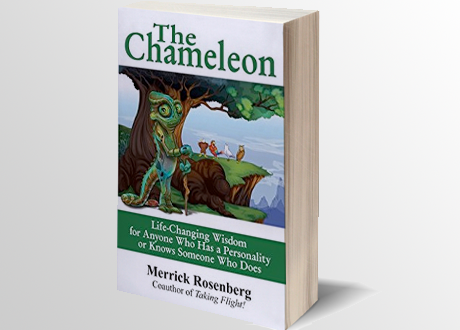By: Amelia Johannsen
After dedicating his professional career to teaching team building in companies followed by fifteen years of travelling the world to teach people about the DISC model, author and keynote speaker Merrick Rosenberg continues his mission in a new book that takes a more playful approach to personal assessment and learning behavioral differences.
If you’re not familiar with the DISC Model, it’s described as “a personal assessment tool used to improve work productivity, teamwork and communication” (Discprofile.com) and it has been used by many companies over the years to improve interpersonal relationships and get a better understanding of how individuals may perform in management or leadership positions. Different leadership styles are thought to coincide with the four different personality types.
In his experience, Rosenberg found that people had a hard time remembering the details of the different personality types and therefore the concepts remained wishy-washy in the minds of his students. To overcome this obstacle, he created new personality profiles, this time based on birds:
- Dominance – Eagle
- Influence – Interactive – Parrot
- Steadiness – Supportive – Dove
- Conscientiousness – Logical – Owl
At first glance I was unsure about the impact this book may have from a professional standpoint—it seems a bit childlike, using animals, illustrations and fables that can easily be read to our children. With that said, I found the book enjoyable and informative—the valuable lessons of interpersonal understanding and communication are all there. I also found myself agreeing with the author, that this approach is easier to connect with and more memorable than the traditional DISC learning materials.
Many of the themes that come up in Innovation Management articles are confronted in this book. These are everyday challenges that get in the way of innovation and progress in the workplace. If management is aware of the different behavioral traits, then situations can be solved before they turn into problems. Here are a few examples:
How to communicate your ideas
The where, when and how you communicate your ideas—as well as the reaction you should expect in order to avoid feeling discouraged—all depend on the behavioral style of your superior. As described in this passage:
“As soon as he arrives at work, he heads directly to his manager’s office. His owl manager is engrossed in a project. She looks up from her desk with an expression that reads, I am busy so make it quick. The parrot does not waste any time sharing his idea. The owl listens intently as the animated parrot speaks enthusiastically. And makes such optimistic claims as, This will change everything!
The owl manager takes a moment to consider the idea and then requests, “That could work, but there are a lot of questions that need to be answered before we move forward. Why don’t you look in to it and get back to me with what you discover.”
The parrot leaves the office feeling utterly deflated. He was hoping for a level of reaction that matched his own.”
Effective change Management
Another common theme we see is difficulties initiating change within a corporate environment. Every organization contains individuals who prefer the status quo and if these individuals are in management positions, they can make everyday innovation and improvement impossible. How we communicate the necessary changes to these individuals is paramount.
“While we cannot push others into a different personality style, we can pull them in the direction of their own. Rather than trying to change other people, we can draw the best out of them by helping them capitalize on their natural strengths, while at the same time, not overusing their innate gifts.”
Leadership and motivation
We have seen this time and time again: A charismatic leader can be your get-out-of-jail-free card. Find a leader who understands human behavior and can act as the chameleon—to guide and encourage people no matter what their style is—then that person can be a game-changer in times of need or they will be the reason your top talent sticks around.
“In the workplace, positive feedback can enhance our sense of achievement, increase motivation, heighten accountability, and lead to greater results. Yet workers regularly cite lack of feedback and recognition as one of their biggest complains. It is one of the primary reasons people leave organizations.”
Creativity
As a hobby artist, I often show my work to friends only to hear their comment, “that’s lovely, I wish I could do something creative.” And I follow up with my usual reply about us all being born creative, but society and educational systems have extinguished our natural creative ability. Most people don’t believe it.
Rosenberg does a good job of explaining how each style is indeed creative in different ways—Creativity doesn’t have to be an artistic masterpiece or the next multi-million dollar idea.
“We all live in a constant state of creativity, but because it is not conscious, we discount it. How we think, react, solve problems, and approach the world defines our creative expression. Yet many of us are not in touch with our creative gifts, so we don’t see ourselves in that light.”
There are many more common themes addressed in this book: team diversity, trust, working outside of one’s comfort zone, problem solving, conflict resolution and more. If you don’t already have a good understanding of the DISC behavioral styles, I recommend giving this book a read. There is a lot of wisdom to be learned.
By Amelia Johannsen
About the author
 Merrick Rosenberg is a keynote speaker, entrepreneur and thought leader on the personality styles. He co-founded Team Builders Plus in 1991 and Take Flight Learning in 2012. Merrick is the author The Chameleon and co-author of Taking Flight!. As CEO of Take Flight Learning, he has led his organization to the be selected by the Philadelphia Business Journal as one of the Fastest Growing Companies and Best Places to Work in the Philadelphia region. Under his leadership, Team Builders Plus was selected as the New Jersey Business of the Year by NJ Biz magazine.
Merrick Rosenberg is a keynote speaker, entrepreneur and thought leader on the personality styles. He co-founded Team Builders Plus in 1991 and Take Flight Learning in 2012. Merrick is the author The Chameleon and co-author of Taking Flight!. As CEO of Take Flight Learning, he has led his organization to the be selected by the Philadelphia Business Journal as one of the Fastest Growing Companies and Best Places to Work in the Philadelphia region. Under his leadership, Team Builders Plus was selected as the New Jersey Business of the Year by NJ Biz magazine.
About the reviewer
 Amelia Johannsen is a digital communications professional working on a variety of projects internationally. She is passionate about functional design and collaborative innovation used to create a more compassionate and sustainable world. As a freelance writer, she contributes to projects such as InnovationMangement.se, The Green Exchange and Handmade Barcelona, while her free time is best spent traveling and in the pottery studio. Feel free to connect on Linkedin.
Amelia Johannsen is a digital communications professional working on a variety of projects internationally. She is passionate about functional design and collaborative innovation used to create a more compassionate and sustainable world. As a freelance writer, she contributes to projects such as InnovationMangement.se, The Green Exchange and Handmade Barcelona, while her free time is best spent traveling and in the pottery studio. Feel free to connect on Linkedin.

